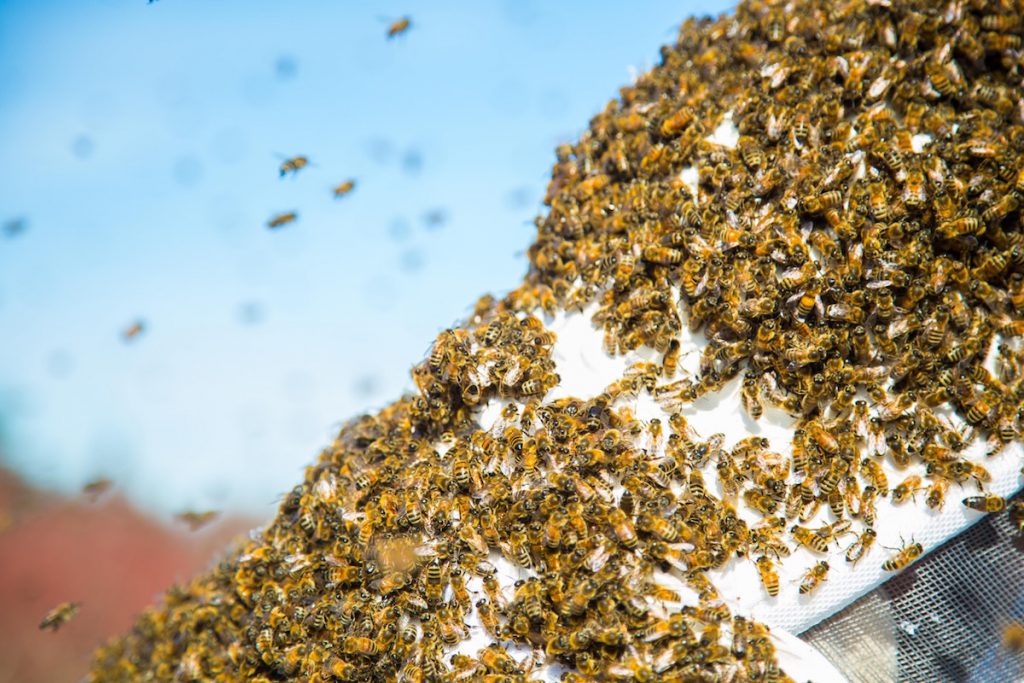What’s the Difference Between Bearding and Swarming?

During the summertime, bees are just a fact of life here in Southern California. We are used to seeing them buzzing around our pools, picnics and soda cans. And although they can be a nuisance, they don’t generally grab our attention.
Sometimes bee behavior is a little more intriguing! Most people would agree that seeing large clusters of bees is something that is quite eye-catching. Today we are going to talk about two fascinating bee behaviors: bearding and swarming.
On the surface, both behaviors may appear to be similar. After all, they both look like large bunches of bees gathered together. However, you might be interested to learn that bearding and swarming are two very different behaviors that serve two very different purposes.
At D-Tek Live Bee Removal, we like to educate our customers on typical bee habits so they can feel confident in knowing when something is an issue and when it isn’t. If you are unsure if your bee situation is a cause for concern, contact our team at D-Tek Live Bee Removal today. Our specialists are standing by to help you 24/7 and to answer any of your bee-related questions.
What is Bearding?
Bearding is one of the ways in which honey bees keep the hive cool. Bearding bees will gather on the outside of a hive in a cluster that looks like a big beard. Of course, this beard is one that you shouldn’t mess with!
In the summer months when the temperatures get high, conditions inside the hive can reach levels that are too extreme for the safety of the brood. There are a number of factors that could create unfavorable conditions within a hive. The hot summer sun heats up the interior of the hive during the days. At this time of year, honey bee colonies reach their highest numbers. All those bees in one small space has a tendency to create a lot of heat.
When temperature levels reach the mid-nineties and the humidity levels exceed 50%, bees need to take action to cool down their environment. This is where bearding comes in! Bees will exit the hive and congregate near the entrance. Bearding creates more space inside the hive, reducing the heat-producing effects of overcrowding. Bees also fan their wings near the hive entrance to assist with air flow and ventilation.
Fast Facts About Bearding
- Most often seen in the mid to late summer.
- Most commonly occurs in the late afternoon or evening.
- Bearding bees are relatively quiet.
- Bearding bees cluster around the hive entrance but do not fly.
What is Swarming?
Swarming is part of the reproductive cycle of a honey bee colony. When an established colony becomes too large for its hive, about half of the colony population will split off from the group. They leave the hive with a new queen in search of another place to call home. While scouting bees search for an ideal spot for a nest, the rest of the bees will form a cluster on a tree branch, shrub, fencepost or other objects. Swarms usually only last for a few hours or a few days. As soon as they find a perfect hive location, they get to work establishing the new colony.
Honey bee swarms are typically harmless. The bees are not aggressive during this time since they do not have a hive or honey to protect. However, they can become a danger if they are aggravated in any way. If you find a swarm on your property, do not attempt to move them on your own. Be patient and know that they will likely move on very soon. If they are a threat, call in the professionals at D-Tek Live Bee Removal for help in rehoming the swarm with a local beekeeper.
Fast Facts About Swarming
- Occurs in the mid to late spring.
- Most commonly occurs in the mid-morning to mid-afternoon.
- Swarming bees are airborne and create a “cloud” effect.
- Swarming bees make a roaring sound.
San Diego Live Bee Removal – D-Tek Live Bee Removal
Bee behavior and habits are intriguing to learn about. Bearding and swarming are two critical honey bee behaviors that help our local bee populations thrive. Hopefully, you are now able to tell the difference between swarming bees and bearding bees.
In either case, if you have questions about the bees on your property or if you need live bee removal services, don’t hesitate to call D-Tek Live Bee Removal. Our live bee removal specialists can help protect your property from bee infestations. Offering live bee removal, bee removal repair and bee proofing services to customers throughout the San Diego area.
